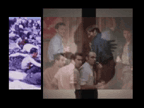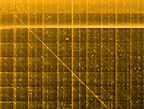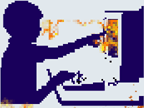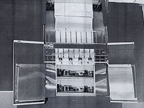:: Sunday, March 28, 2004 ::
 ORIGINAL POST: Sun Mar 21, 07:50:08 AM
ORIGINAL POST: Sun Mar 21, 07:50:08 AM
BY: Kristen Palana
"Slowtime? -Quicktime as an Artistic Medium"
Quicktime is one of the most popular file formats for streaming media, and it’s the format of choice for producing video for the Internet. According to Slowtime, Quicktime also has several features that make it an expressive and unique artistic medium.
The title “Slowtime” is meant to symbolize the range of possibilities of this time-based medium, including its interactive and 3D features.
The show was curated by Agricola de Cologne for Cinematheque. Due to the show’s wide range of net artists and styles, it has been divided into four parts--the most recent being launched February 19th of 2004. Though viewers have access to the entire show, it is this most recent edition (the 4th) that I will focus on briefly today.
Dana Cooley’s “Be Quiet 2003” is an interesting visual commentary on the nature of Quicktime as more of a cinematic scrapbook rather than a full-on Hollywood movie experience. Her images capture fleeting moments that hiccup and loop along with changing texts.
Arlene Ducao has a three-part, 3D animation entitled “The Penetrating Needle (2002).” The figures depict person-to-person interactions, both “mundane and necessary systems of generosity and mistreatment.” The fact that the animation is in three parts addresses the fact that most Internet Quicktimes must be adjusted for length and quality due to bandwidth limitations.
“Monitor” by Kevin Hamilton is an interesting depiction of a looping clip from a famous American war epic, presented as surveillance footage where a figure performs a repetitive act to mark time. The fact that the clip is a loop creates an uneasy feeling of being trapped in time.
There are many other notable works by net artists in the show. My only complaint about “Slowtime” would be the lack of a “skip intro” button and that some artists' works are unavailable due to each artist having their work on separate servers. Overall though, I found the show to be an excellent showcase for the potential of Quicktime video.
 ORIGINAL POST: Sun Mar 07, 10:44:57 AM
ORIGINAL POST: Sun Mar 07, 10:44:57 AM BY: Garrett Lynch
Golan Levin's The Secret Lives of Numbers, was one of the four distinctions in the Net Vision category of the Prix Ars Electronica 2003 yet has been little mentioned since, considering we are a society so obsessed with numbers / data / databases / archiving / searching / retrieving / collating and visualising.
The work is essentially a collection of data retrieved from searching the internet at intervals since 1987 "on the popularity of numbers: by performing a massive automated Internet search on each of the integers from 0 to 1,000,000 and counting the number of pages which contained each, we have obtained a picture of the Internet community's numeric interests and inclinations." Through this "interactive visualization" the resulting "data can be explored point by point, or viewed in larger sets, and may lend some insight into the cognitive structure of numeracy, culture, and memory".
In visualizing data such as this patterns become visible, the length of zip codes, the amount of toll free numbers, the correlation between numbers and meaning, such as 90210 the television show or base-2 as used in computing. Whether just for the appreciation of data as abstraction or a comment on societies trends, The Secret Lives of Numbers is a net work well worth seeing.
 ORIGINAL POST: Wed Mar 03, 12:50:46 AM
ORIGINAL POST: Wed Mar 03, 12:50:46 AMBY: Peter Luining
De nieuwste versie van criticalartware (versie 3.1415926535) introduceert "liken", de nieuwe substructuur van criticalartware.net [applicatie/platform]. Nieuwsgierig naar de introductiemail die op een aantal mailinglijsten verscheen ben ik een kijkje gaan nemen. Bij binnenkomst zie je een tekst waarin uitgelegd wordt van "liken" is. Je zou "liken" het best kunnen zien als een database waaraan de gebruiker zelf informatie kan toevoegen in de vorm van knopenpunten. De wegen die op hun beurt deze punten weer met elkaar verbinden zijn aan verandering onderhevig. Een verandering die bepaald wordt door de populariteit van de knopenpunten. Omdat "liken" in open xml is geprogrammeerd kan iedereen alternatieve interfaces voor liken ontwikkelen, en meeontwikkelen aan de unique structuur van "liken". Kortom een alternatief en rhizome- achtig (in de Deleuziaanse zin) model.
Theoretisch en technisch zit het helemaal perfect in elkaar, maar er zijn natuurlijk ook gebruikers. Een daarvan zou ik kunnen zijn. Maar ondanks dat ik een half uur in 'liken' heb rondgesnuffeld vond ik het allemaal erg ingewikkeld. Zaken als hoe start ik een knooppunt en hoe beweeg ik me door "liken" gingen me niet direct simpel af. Hierbij moet is het de moeite waard te vertellen dat ik mezelf als een internetter met redelijk veel ervaring beschouw, dus voor een gewone internet gebruiker moet "liken" een ingewikkeld iets zijn. Hij (de gewone gebruiker) zal waarschijnlijk snel verdwijnen ook al zoekt hij naar bepaalde informatie in "liken". En hiermee kom ik dan meteen op het punt van kritiek op projecten zoals "liken", ze zijn te ingewikkeld hoe mooi de boel theoretisch en technisch inelkaar zit en zullen uiteindelijk weinig succesvol zijn juist omdat er zo'n grote inspanning van de gebruiker wordt gevraagd. Daar komt bij dat juist de mensen die hier simpel mee aan de slag zouden kunnen weer niet geintresseerd in deze experimentele opslag methoden. Ik denk dan ook dat projecten als "liken" eerder een waarde hebben als kunstwerk dan een echte database.
http://www.criticalartware.net/
http://www.criticalartware.net/lib/liken/
 E X T E N D E D . F E A T U R E
E X T E N D E D . F E A T U R ENEW WRITING: no/copy/right
BY: Garrett Lynch
EXCERPT: no/copy/right is an online exhibition that has just been opened by no-org.net, a "new Jerusalem art network envisioned as a platform for experimental projects in the area of netbased and digital art and for the exchange of independent information on contemporary art."
Subsequent to a call for works on the theme of anti / counter copyright which went out through most mailing lists at the start of this year for a new net.art 'space' completely unknown to the community, I have been regularily checking the site to see how well the exhibition fared. It's a shame but many online exhibition ‘spaces’, which have had promising debuts, have not been in successive exhibitions or have quite simply been pushed out by the mainstream art world.
click here for the complete article.
"no/copy/right" by Garrett Lynch will be featured through 4 April 2004.